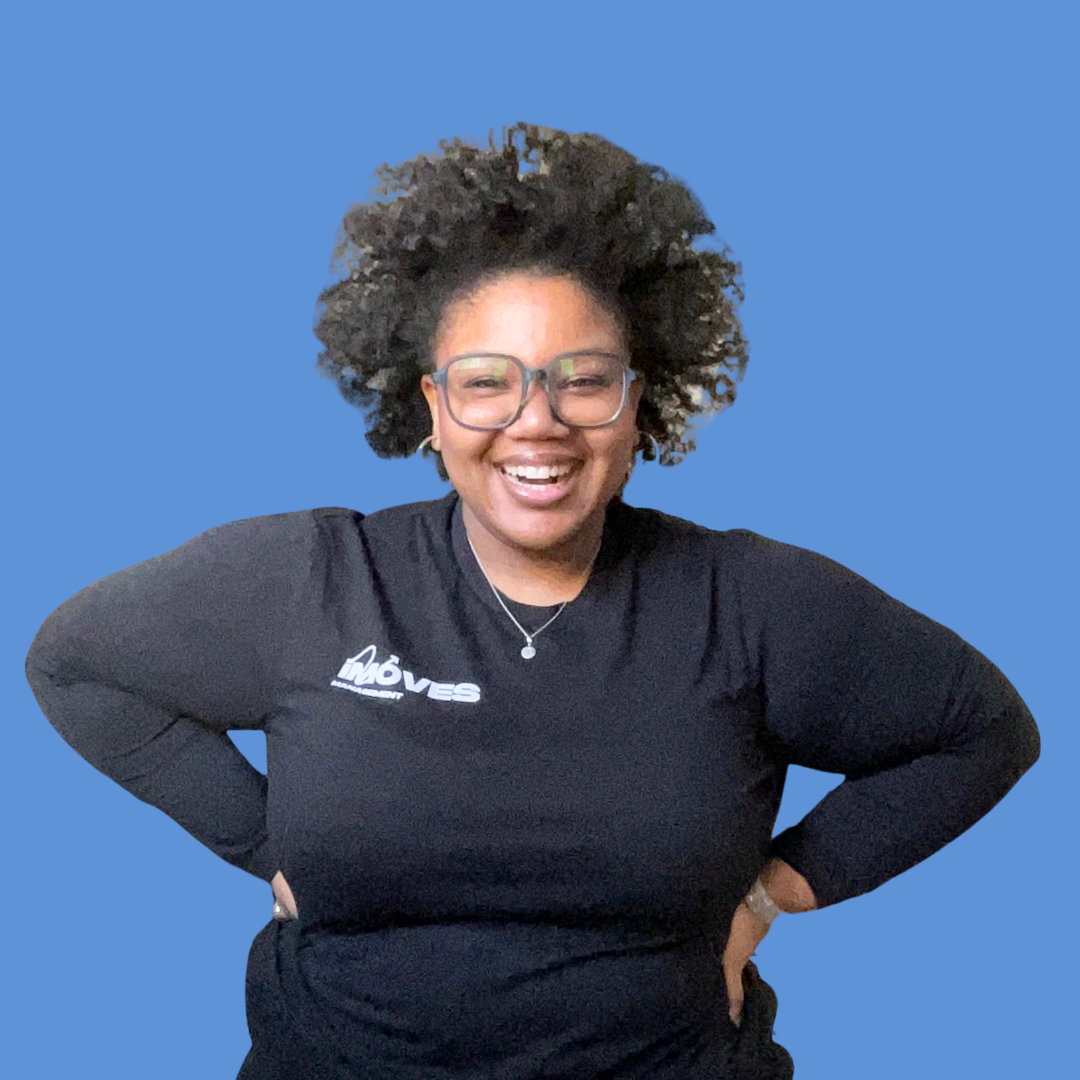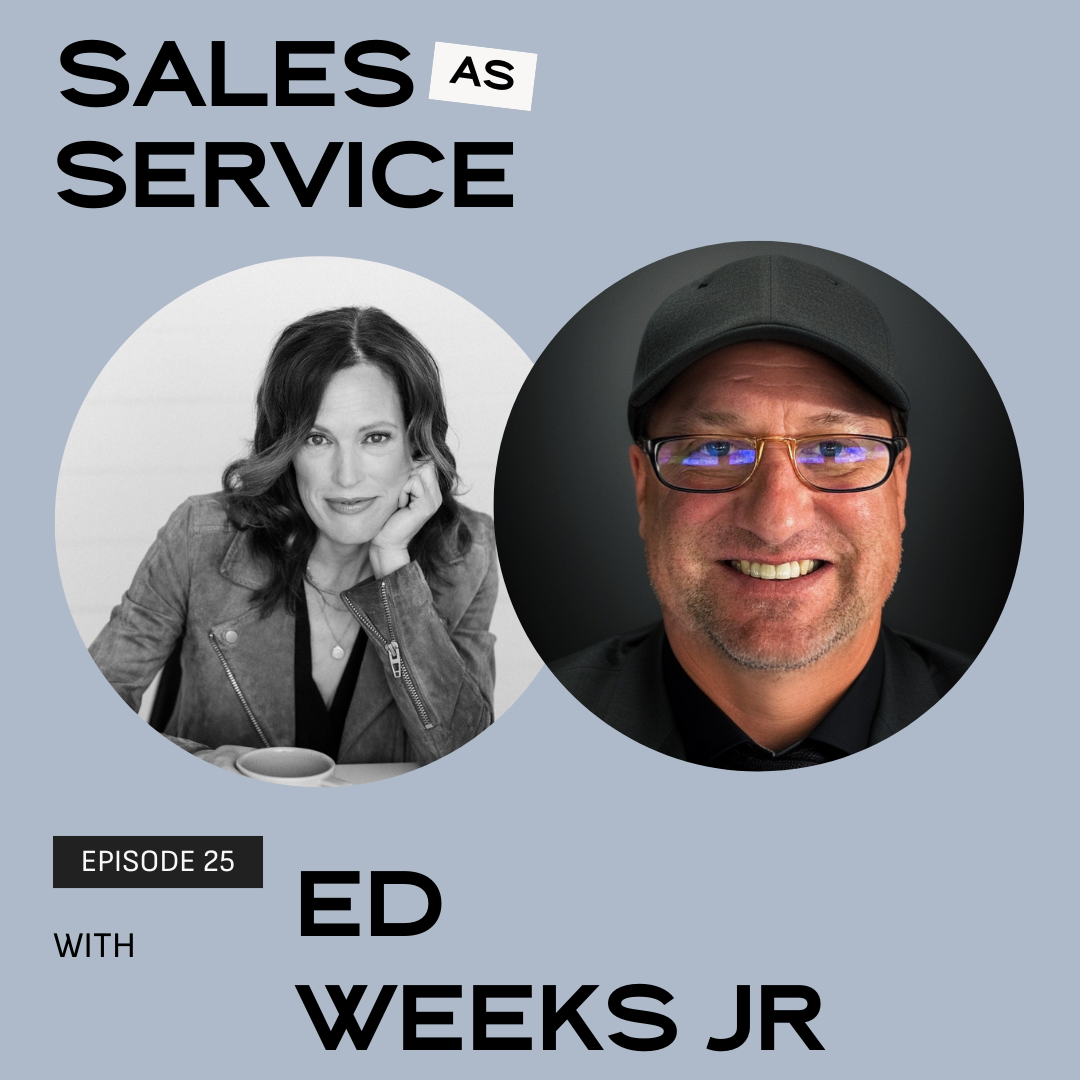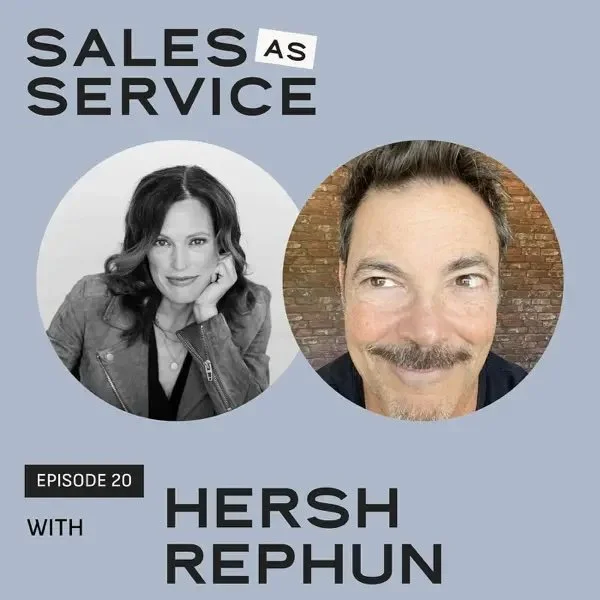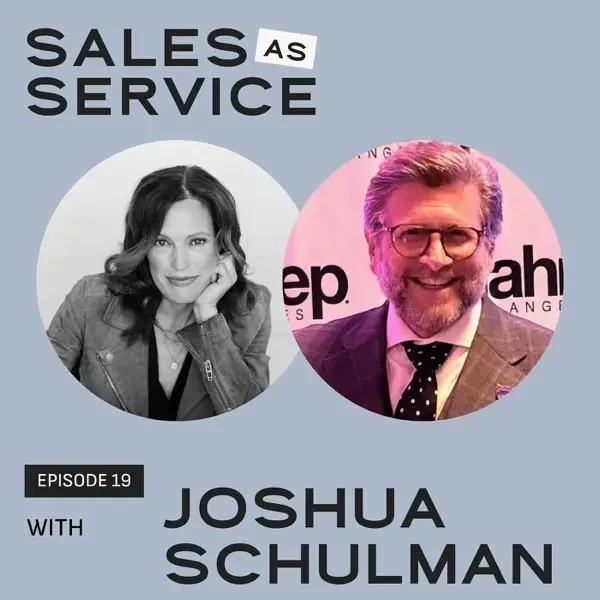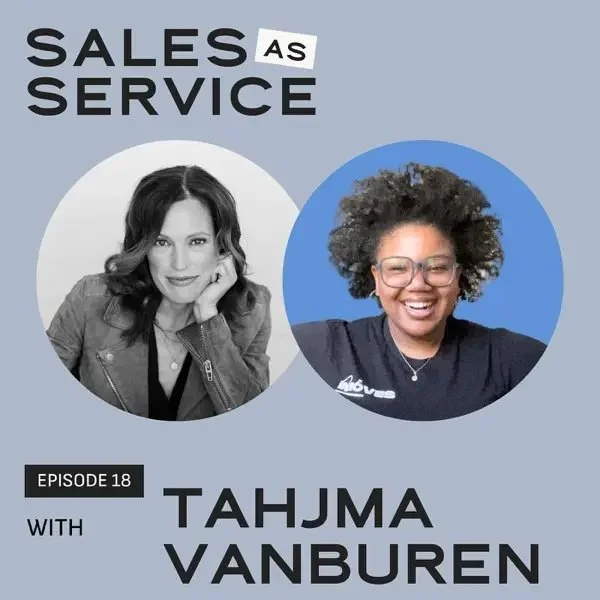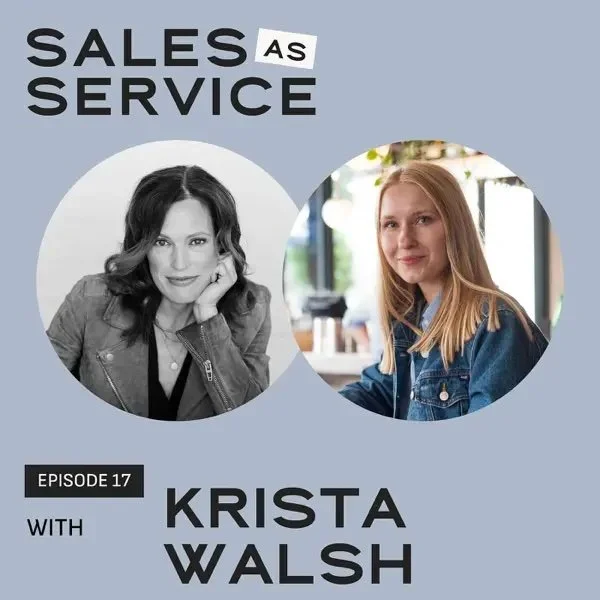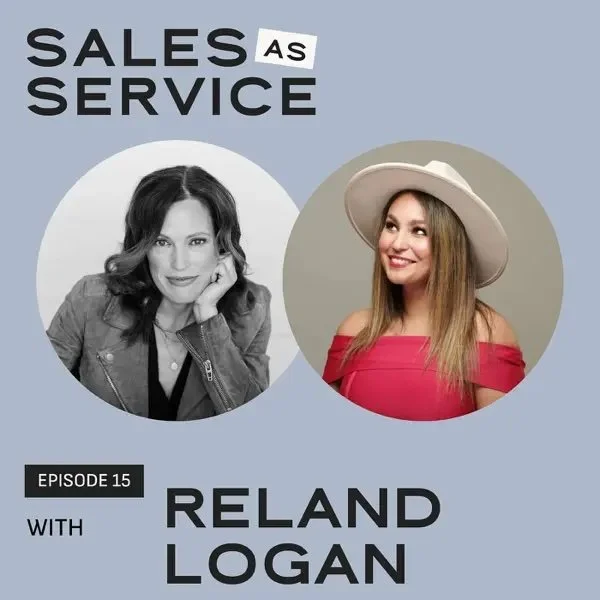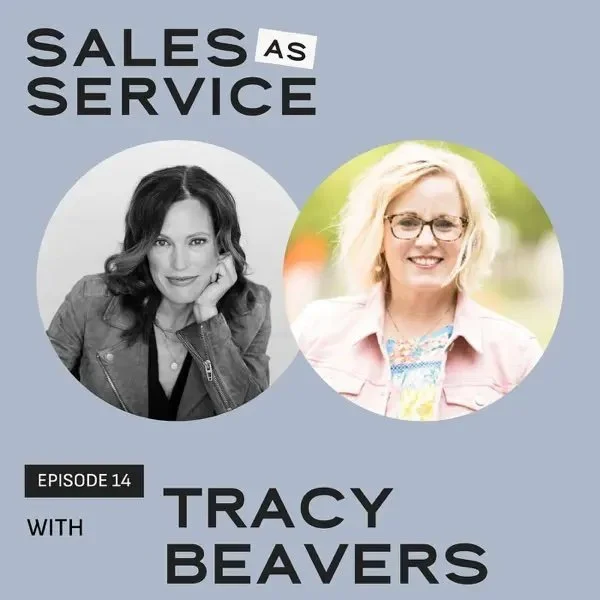Content That Converts: Why One Platform Is All You Need with Tahjma VanBuren
EPISODE: 18
If you’ve ever felt like you’re doing all the things—posting here, showing up there, and still wondering why it’s not translating into sales—this episode is for you.
I’m joined by podcast strategist and founder of iMoves Management, Tahjma VanBuren, for a conversation about what happens when you stop chasing every channel and start showing up with intention.
We talk about how to shift from content overwhelm to focused creation, and why building consistency on one platform—like podcasting—can unlock real traction in your business.
In this episode, we cover:
Why choosing one platform to master is more strategic than trying to be everywhere
How podcasting supports your sales process—even before the first conversation
What “creation over consumption” really looks like in practice
How to repurpose one piece of content into a week’s worth of visibility
Why a consistent digital presence can shorten your sales cycle and attract right-fit leads
LISTEN TO THE EPISODE HERE 👇🏻
-
[00:00:00] I like to consider podcasting, like marketing on steroids, because if you're doing it right, 45 minutes of a recording, you can get 17 different social media clips from it. You can get at least three different blog posts from it, email newsletters, the whole gambit, all of the things that people are talking about when it comes to.
Organic marketing. You can pull from a 45 minute recording. Welcome to Sales Is Service, a podcast designed to help you change your mind about sales. Literally, I'm gonna help you change the way you think about selling. I'm Tam Smith, your host sales Bessie, and pitch partner next door. You're tired of bros with biceps telling you how to crush a million dollars in your sleep or battling imposter syndrome on your own.
You've come to the right place. All you need to do is listen, then take action. No gym membership required. Let's get started.
Quick question for you. How many new business inquiries did you generate in the last 30 days? How many were actually sales qualified, [00:01:00] and how many of those converted into paying clients if your results were inconsistent or, hey, maybe you don't even know how to answer that, we need to talk. That's why I created the five minute sales audit.
In just five minutes, you'll walk through a simple set of questions about your sales process, and within three business days, I'll send you a personalized video audit and a detailed PDF checklist. You'll see what's working, where the gaps are, and one low lift action you can take right now to improve lead generation and client acquisition.
It's quick, it's actionable, and it'll give you clarity on what to fix Next. Book your audit today at Studio three 40 nine.com/sales audit. Alright, let's get into today's episode. Welcome back to Sales Service. I'm your host, Tam Smith, sales growth strategist and founder of Studio 3 49, sales, marketing, and I have a confession to make.
I'm betting a lot of you can relate to. I've been my own worst client trying to show up everywhere, do everything, be all the things to everyone at my best. I'm inconsistent at my worst. Well, I do nothing. I tend to be a little bit of extremist. If I can't do [00:02:00] everything, I do nothing. So I made a decision to stop chasing every channel and instead focus on the one or two places I know I can show up fully for my audience of female founders and agency owners.
And for me, that's this podcast in LinkedIn. That's why I've recently moved to a weekly publishing schedule and I'm focusing my social media efforts on LinkedIn so I can build real consistency, which makes today's guest the perfect voice for this conversation. Taj Ma Van Buren is the founder of I Moves Management, a podcast production company that helps service providers stop blending in and start using podcasting as a business asset that builds trust.
Visibility and momentum. Her motto is simple but powerful. Creation beats consumption because you can scroll, you can swipe, you can consume content all day long, but nothing moves the needle like creating something of your own and in a world that pushes us to be everywhere. Tashma is a loud advocate for going deep on one platform [00:03:00] and building something sustainable.
Today we're talking about how podcasting can anchor your content strategy, how to measure success beyond downloads and what founders need to know before they hit record and expect results. Because showing up once won't change your business, but building a body of work that sounds like you. Absolutely will.
Here's our conversation. Thank you so much for being here. Thank you. And first up, always like to start these conversations. Tell us who do you help and how do you serve? Sure. I help service-based business owners that are looking to use podcasting to kind of three x their organic marketing. So they're using a lot of social media.
They're using a lot of non-paid ad space, but they wanna be able to get some of their time back on that front. Yeah, absolutely. I was reading some a post this morning on LinkedIn and it was talking about, you know, in. 2015, you know, the, kinda the response from a perspective client was, oh, just send us a brochure.
And now, you know, in 2025, you know, before the sales conversation even [00:04:00] happens, they've already, they've gone to your website, they've read your Google reviews, they've, you know, uh, researched your company and they, they've done their homework. And the, the, the sales conversation really happens before you even have that, you know, one-to-one conversation.
And I, you know, like. I have to emphasize that so much to the businesses that I work with that still think that a consistent digital presence is a nice to have instead of a, you know, a have to have or, you know, a must have. And I think the, you know, so many entrepreneurs that you get overwhelmed and don't do anything 'cause you think you have to show up everywhere.
What's your take on that? I don't think you have to show up everywhere. I think that is the quickest way to burn out as someone that has been there. Multiple times. At some point I had to really dial into, okay, Taj Ma, what's working for you? Where do you actually want to exist? Because truth of the matter, there's so many different marketing tools that are out there, and I promise you every single one of [00:05:00] them actually works.
If you work the plan, they all work. It's just where do you wanna actually show up? So my thing is, I, if you find me online, I'm on LinkedIn and on YouTube and I don't touch any other platform. Not because I don't want to, but because that's where my energy allows me to do it. Yep. How did you land on, I think new podcasting is really, you know, I refer to like your anchor content.
How did you land on that? Is like your focus anchor content for all of your kind of, that really fuels all of your visibility. So podcasting, there's two things. One, it really, I like to consider podcasting, like marketing on steroids, because if you're doing it right, 45 minutes of a recording, you can get 17 d.
Social media clips from it. You can get at least three different blog posts from it, email newsletters, the whole gambit, all of the things that people are talking about when it comes to organic marketing. You can pull from a 45 minute recording. One, but then two, a [00:06:00] lot of times people think about marketing and we're constantly hearing.
We need to make people feel something. We need to make people feel something. And that's 100% true. And I don't think that you can do that in any other capacity as fast as you can. With a podcast because if you've gotten somebody to your podcast, they're invested. They wanna hear what you have to say, they wanna experience that time.
And that's actually where I, where I ended up feeling seen and feeling heard. And I said, oh wait, there's some money on the other side of this. Let me figure out to do this. Yeah, absolutely. So even beyond visibility, it really, you know, do your. Point it, it works to build trust and lead to sales. Can you, can you walk us how that transformation happens?
You know when it's done right? Yes. So when you are really, your podcast is considered. The awareness is kind of top of funnel. It's where you're getting people interested in what you have to say and then they're converting into that [00:07:00] sale, whatever that sale looks like for you. A lot of times that looks like, okay, I've gone from my social media clips, which is why it's so important to pull as much as you can from those 45 minutes.
Your social media clips too. Now let me see what they're talking about. 'cause. I've watched like three, four different clips of this episode. Let me actually watch the full 45 minutes or listen to the full 45 minutes. Now I know who this person is. It's moving them from the know, like, and trust factor very, very fast.
And then by the time that they're spending all of this time with you. People are listening to podcasts in the shower, at the gym. In between work, they're absorbed. You and your brand are absorbed into somebody's daily activity. You've been able to answer questions that they already have because if you're doing the podcasts well, you're answering questions that you're probably getting consistently, you're having different features.
And then they say, okay, well now it's a no brainer for me to think, oh, Tam does business development. [00:08:00] I hear her all the time. I'm sure that she knows how to do this particular thing in my business. Let me follow up with her. It's a exposure game, if you will. Mm-hmm. Do you have any strong opinions as far as, you know, audio versus video or, you know, if, if, if you have to cheat, should you do both?
Or is it okay to do one versus the other? What's your take on that? So yes and no. I. Used to not have a strong opinion about that. I used to think that it really just depended on your demographic that you were focused on. However. With this surge of video as well as particularly AI content. I think video is absolute, you need it because it, again, it gets people to know this is a real person, this is someone that has real life experiences.
This is someone that can actually connect with this experience that. I'm having and I can see them, which makes me feel a lot more trust. They're full podcasts that are 100% AI that drives, yeah, it [00:09:00] blows my mind. It's kind of cool, but then also kind of scary at the same time. Yeah. Yeah. It totally, and I, I've started now even on, you know, my LinkedIn experience when I, you know, have anyone that's doing, you know, outreach to me, when I'm looking at profile of pictures, some of them are like almost too polished that I look.
I'm like, is this, is this a. Is this a real human being or is this, I, it's really hard to discern, but there's a point where things just look a little too perfect. So to the point of being able to show up as a real live human being, how that there's even more value now in the season that we're in with AI and having this, and I will say, even if you decide to do audio only for a a little bit of time, so for example, one of my first podcasts, I did audio only, but I always recorded video.
So that if you wanted to go back and say, now it's as available on YouTube, then that's fine. Just record something in video. What is your approach to that? And really how to leverage the content, [00:10:00] you know, across all types of, you know, marketing platforms and give it. The most legs. So I like to squeeze a episode dry.
I like to make sure that I am going through this particular 45 minutes to an hour and seeing, to the point where I, I try not to use as much. Like I'll use tools like Riverside and DS script to pull out the best pieces. But then there was another layer where I'll go through and I'll watch the entire thing to see.
What's a personality post that I can pull from this? What's something, what's a question that someone probably has associated with this and one of the easiest ways that I can describe it, 'cause I'm sure that we have all heard all the things I mentioned earlier, which is turning the episode into a blog post or social media.
How do you actually know it's worth it? I think one of the things that I really internalized is you are getting paid from this content, not just in money or you're getting, we are getting paid, not just in money. I think [00:11:00] we get paid in money, people's attention and people's data. So if you're able to look at this particular episode and figure out, oh, I'm getting people's attention from these social clips, but how do I grab their data from this?
Is there a freebie that I can create based upon this podcast episode where I can then capture their data as well? That's real. Pulling it, getting it bone dry. How do you define, like, what are the metrics that you look at to define like success? Like when you're trying, you know, a new. Tactic, if you will, to determine like, Hey, this is worth repeating.
'cause I appreciate like, the, the point of this is, you know, not to be everywhere, not to do everything, but to pick, you know, the one or two things that you are, that are really working for you. So how do you, what do you look out to determine, okay, what's successful that you wanna keep doing? I think that goes back to the goal that you had for starting the podcast in the first place.
Sometimes people's goal is I just want to be able to have a streamlined process for creating social [00:12:00] media content. And if that means that the goal is I wanna be able to pull out at least 15 different clips or different, sometimes I'll create memes out of myself from my podcast stuff. That's the goal.
That's cool. Then if the goal is to make money from the podcast without bringing in sponsors, so for example, I have a client who we specifically optimize his podcast content so that he shows up in Google search results, not so much for views. The views are important, but we wanna be able to get him speaking gigs.
We wanna be able to get him into workshop facilitator spaces. So it depends on what exactly you started this particular podcast for. Is it just another revenue generating stream? Because we can pull out all the different pitches for sponsors and all these different things. It just depends. I really appreciate that too.
'cause it kind of goes back to that, you know, don't just post a post or don't just do something for the sake of doing it. You know, before you get started. Really, [00:13:00] you spend some time thinking, what is the goal? What am I trying to accomplish with this? And then, you know, pick the, you know, the two or three metrics that you're gonna measure, you know, to get those.
Feedback signals to say, Hey, okay, this is worth, this is worth doing and worth repeating for me with my own podcast experience. Like I, it was a, you know, I realized in my business when I made the pivot from, you know, being on the marketing side, you know, doing the content marketing for clients to pivot more to the new lead generation, you know, business developed conversion, end of it, I.
I knew the value and the importance of having a consistent digital presence, but it was definitely, you know, it's like the cobbler with their shoes. Everybody else's knew that I was working on looked great, but I wasn't taking care of my own, and I realized I could not. Be advocating to clients the value of a consistent presence.
If I was not leading by example, and if for me, I found pod, you know, podcasting has become, you know, that that anchor content that, you know, it's a, it gave me a system to be consistent and it's given me that [00:14:00] system to do it. You know, now I'm kind of, you know, maybe further along now that I'm getting in to actually look at, okay, you know, how can I better leverage this?
You know, first it was getting the reps to actually do it. And it's now, how can I better leverage this in my business? Uh, so that's helpful to know, kind of pick the goal and then reverse engineer it. Correct. That's a really good way to describe that. Even if the goal is not to be a podcast host, because sometimes the goal is to be a guest all over the place for podcast, which is just as useful sometimes you just wanna get your name out there.
You wanna become a household name as the goal. From a podcast guest perspective, where as other times you wanna be able to grow your email list. Choose the goal and then run with it. And the goal shouldn't be just because someone told me, oh, you should start a podcast. Yeah, I don't. Don't just start a podcast.
Start a podcast. Yeah. There's so much you could be doing, you know, and there's this pressure that. You know, kind of back to the start of this conversation, this pressure that we should be doing everything. No, you shouldn't. And you know, and especially [00:15:00] we start to listen to other founders, business owners that are, oh, well I'm doing, you should be doing this, you should be doing that.
And I always have to. I mean, I frankly have that internal conversation with clients all the time. Is. They, we decide on something and then they go and talk to another business owner, friend, you know, that's in a completely different space with a completely different audience. But there's this pressure, oh, they're doing it.
I should be too. Wait, let's take a look at, you know, again, who is their audience? You know, what is their goal? Like, what is that? Just because they're doing it, does it mean you should be too? So just take the pressure off your self audience. You don't have to do everything. Yes. And that other person could be doing it terribly.
They wanna convince themselves that they're doing it well? Yes, yes. Are you showing up on LinkedIn but not generating leads or referrals? If you're posting and growing your network, but still not seeing consistent results, the issue likely isn't you, it's your system. Most people don't realize that five to 15% of their LinkedIn [00:16:00] connections could be potential clients.
That means your next few sales calls could already be sitting in your network. You just need a strategy to reach them. That's exactly why I created the LinkedIn Lead Generator Challenge. It's a free five day experience to help you turn your profile into a lead generating machine. Inside you'll get access to a plug and play outreach sequence, profile tweaks that attract the right people, and a daily system for outreach and engagement that takes less than 30 minutes to follow.
It's the same method I use with clients to help them build visibility. Create real connection and generate consistent pipeline, all without the salesy energy. So if you're ready to show up on LinkedIn with more intention and lead with value so you can finally see results, head to studio three 40 nine.com/linkedin-leads and join us.
Alright, let's jump back into it. What are some kind of overlooked ways that you could repurpose content? To support sales and client conversion. I mean, we were talking ahead of the recording. You gave me a, like a great idea. You know, with my own [00:17:00] guests, I have not really been leveraging our own content as well, you know, sharing it with them to, uh, using their own channels.
You know, I was sharing, you know, kind of the thumbnail image, which, you know, we were talking. Course it's not gonna get shared 'cause it's my brand, not theirs. But at least giving them, you know, access to the raw, you know, clips and materials to be able to share. So thank you. That was a, you know, great tip from you for me.
One, what other things like that, you know, maybe people overlook that they're not, you know, using their content in the best way. The one that immediately comes to mind is if you end up wanting to take a step or dip your toe into paid ads. Podcasting is a really good way to do that. So in the past I would.
Be recording all these different things, and then this is pre podcasts. I would be recording all these different things and testing it, seeing what the response is, and then that piece of content would then become a paid ad. But if you're able to test the content over and over and over in a podcast, it's a.
Very deep way to know, oh, [00:18:00] I should probably make this 30 seconds work for me in a paid ad to get people to whatever offer that I'm trying to do, whether that's free or paid. Now are you looking at, what metric are you looking at to determine what you would, what you would put paid advertising behind? I think it's a couple of metrics, which is also another reason why I say video is so important.
One of the things, not all the audio only podcasts. Dashboard Analytic dashboards tell you as much in-depth detail about when do people drop into a conversation versus when they drop off. As far as if you ever scrub on a YouTube video, you're able to tell, oh, most people are listening to like minute seven.
To 15 and then they kind of drop off. Or most people are listening to minute 25 and then they kind of drop off. Being able to grab that information is very useful 'cause then that tells you, wait, what's happening between seven minutes and 15 minutes? That tell me that people are interested in [00:19:00] this?
People are are wanting to hear this information. The other thing is you can look at impressions somewhere within the social media space, people. Started caring a little bit more about impressions rather than engagement. So impressions more so tell you, oh, this got eyes real quick. But then how does that match up with engagement?
Because sometimes engagement is more important. So you being able to pull that piece of clip from your podcast episode, test it on social media is gonna be great. Even better. I would say test it on YouTube or TikTok first, and here's why I say that. Even if you don't have a presence on those platforms, the algorithm that they have is insane.
You're able to tell a little bit more. What are people actually interested in? And it's not your Facebook friends, it's not the same couple of thousand Instagram followers that you have that are engaging with the posts. It's raw. Do you like this or [00:20:00] do you not? 'cause YouTube is pushing it out or not pushing it out.
Depending on what the first 200 people say, then the first thousand people that view that particular short say to being able to test it. I. Love that. That's kind of the, it's a very different, you know, most of the clients I work with, you know, at the point in their business, they, they are, you know, have built a, you know, a strong branded business, you know, on referrals, you know, alone.
And it's gotten to a place, okay, that's either inconsistent or they're trying to grow beyond that. And, you know, all the sales conversations that they've been having to this point in their business have been largely, let's just call 'em warm. You know, because they've either, it's been. From, you know, six degrees of separation.
Some they, someone from somewhere in their network. So it was essentially, it was like a, a familiar, there was some familiarity there. There was already, you know, brand recognition, thought leadership. But when you talk about putting that message in front of an entirely cold audience, that's an entirely different conversation.
And so using YouTube or TikTok is like. To [00:21:00] measure, okay, how is this gonna resonate in front of an audience that's not familiar with me? Uh, that's a great tip. Love that. Now you gotta have thick skin for that. 'cause that audience is gonna be very honest. But it's, it's good. And I think like that's a great to talk, like growing beyond, you know, your.
Comfort zone, if you will. You know, you hit a certain, anybody a certain point and everybody's not trying to scale. You know, I, I did get that, you know, but if you are looking to grow and scale beyond kind of that warm, familiar network, you know, know that, you know everybody's not gonna like you and that's okay.
Um, you know, you're putting. You wanna put things out there to resonate with your right audience and just understand that, you know, I mean that's a lot of the internal, you know, conversation I have with clients too. You know, so much around mindset 'cause it's the first time they are trying to get, you know, doing outbound business development techniques, putting themselves in front of a cold audience that doesn't know them.
And it is a little like. That fear and [00:22:00] insecurity and you know of reject. That's all it is. And I just have to reassure folks, there's nothing wrong with you. You know, everyone's not gonna like you and that's okay. Like you could be the juiciest peach in the world, but if someone doesn't like peaches, it's just, you're just not for them.
And that's all right. You know, it gives you room to find the next, the right one. I even add that I would consider reframing it to data. People that say that they don't like you or whatever piece of content that you put out there for whatever reason, that's just data. If you kind of suspend your emotions around it, it's data to tell you, oh, they don't like me, but my audience does like when I do that.
So maybe I should actually just double down. On that particular aspect of myself that my audience does like, which then further repels the people who aren't going to wanna do business with me. Yes, love that. For someone that's out there that does not have, you know, again, either has an inconsistent or non-existent.
Digital presence and they decide, okay, now's the time I need to get, you know, get, start [00:23:00] something that is going to, you know, gimme that engine to have a consistent presence and they land on, okay, podcasting is the thing for me. Where should they start? What's kind of the first step for them to, to get out of the gate?
So I love this. The very first thing first that we, I would say start with is gather the same eight questions that people are probably asking you over and over and over and over. And if you scour through your inbox or your dms, I promise you somebody's asking you the same question at least three different times.
And that's enough to say, okay, let me add that to my list of questions. And with those eight questions, you're now gonna turn those into eight different podcast episodes. So that I say eight just because it gives you a time, enough time to be able to figure out, do I actually like podcasting? I thought I wanted to do this, but I don't like the routine or I don't like how this feels, I don't like my voice.
Whatever that looks like for you, just try the eight. Start with eight questions that people are consistently [00:24:00] asking you so that it's searchable content. 'cause you know people are already finding it. You're not gonna wake up and get one view on something or whatever that is, 'cause you answered someone's question and then from there you're able to.
Like I said, feel it out. Figure out if this is something that you consistently wanna do, and just aim for like 20 minutes in that. A good example of this is there's a massage therapist that's in the town that I live in, and she wanted to start a podcast for her niche audience. And I said, okay, let's, let's hold on.
What are the questions that people want to, that are people consistently asking you? Or what is the question? What are the things that you feel like you keep saying all the time? And for her, that was before you come into a massage appointment, this is what I need you to do after you come in for a massage appointment, this is what you're gonna wanna do.
Drink the water. Please don't go work out after you. Had a massage, all these different things. Here's how you feel [00:25:00] comfortable, 'cause you're getting dang near naked with this, with this stranger. What are those questions? Right? That you're consistently getting Record that. Don't try to make it fancy, just see if people want it first, and then see how you feel about it.
Mm-hmm. Mm-hmm. That's such great advice and it's like I've. Advice I give, you know, to clients as well. It's like you, before you invest all of this time, money, whether you know, it's pi, whatever it is, some marketing tactic, new offer, whatever it is, it's like find out if it's something that the market even wants.
'cause you're just gonna burn yourself out and frustrate you, which at least is there anyone that it's not a right fit for, you know, that you would recommend them, you know, because it, it may not necessarily be for everybody. There's other things out there. Do you find that it's. Not the right fit for some folks, and you end up like recommending folks to go a different direction or, I think with podcasting it is a, it's a muscle that you are going to have to grow.
So patience is probably going to be the number one thing that you are going to have to endure because it's, [00:26:00] if you are just starting out, it's kind of like a wait and see. Model, which I know is very opposite from what you, you talk about from a sales perspective, but you're waiting to see what do people want to hear about?
Did they resonate with this? If you are not a person that's not willing to put on your scientist hat and be okay with testing things out, you probably wanna pump the brakes and see what's a faster way for you to get where you're trying to go. Because with podcast, this is, I think it really works well for people who are a little bit more introverted.
I myself am a little bit more introverted. I don't do that well with small talk because how many times can we talk about how great the sky looks? 'cause it looks great. Let's move on. I wanna get into the deeper conversations. But if you aren't that kind of person that really has something that you wanna talk about and then.
You're done or you're not willing to exercise patience [00:27:00] or grow the muscle of being a scientist, if you will, about your content, then I would say. Maybe try something else and be okay with, I mean, I'm the introvert, you know, so for me it's been a, a great space and I had to give myself the freedom of like not being good at something and that's okay.
And that it is just reps in practice. I'm sure you know, I list, there's podcasts that I follow do that they're, you know, hundreds of episodes in, and I can't compare myself against that. I'm sure there's gonna be a point when I hit that, you know, where I can go back and, you know, listen to the, the trailer episode that was excruciatingly difficult for me to get out the gate and listen to the early episodes and I'll be like, oh, you know, that it is really just a consistent practice like anything else.
And, you know, for my goals it gave me the first time in my business, you know, that I've had any kind of, and it's still inconsistent, even with a podcast, you know, depending on my bandwidth. 'cause it is, you know, me doing all the backend. Marketing promotion of it, but it is the first time in my business I've [00:28:00] had any kind of consistent.
Visible presence and it's just 'cause it's given me, that served up consistent content for me to share value with the audience. That's awesome. So yeah, I can talk a lot better than I can write a consistent blog post. So it's been a a great, that was sort of my, I had tried, you know, I guess my. Try and fail was doing, you know, blog content, you know, early on.
And I was, you know, that was really hard for me to be consistent with. And this is the first thing that, you know, I've had any sort of consistent track record of showing up and feel like I'm able to consistently add value to the audience that I'm serving. So I rec, it's not for everyone, but I recommend it, you know, to your point, like just try it, you know, it is a series of like kind of putting yourself out there and experimenting to see what, what works from both A, okay, do I like this?
Can I sustain it? And you know, what is actually, you know. Driving results for my business. And then if you try those eight episodes and you're like, I don't, I don't really wanna do that again, then just turn it into a little [00:29:00] leap magnet and say, Hey you, thanks for signing up for a discovery call. Here's a couple of questions that people consistently ask and then point 'em to the podcast.
It's still worth the time and the investment that you put into learning if that's something that you wanted to do. Absolutely. Let's jump into our Fast five. Your, I can't live without its software or app. I have two. Is that okay? Yeah, absolutely. Okay. From an organization standpoint, I'm gonna go with as.
I put everything in Asana, and then from a podcasting standpoint, it's probably gonna be Veed, so VEED, pulling things outta there, editing the different social media clips, chef's kiss. I'm gonna check that one out. Thank you for the tip. Best advice you've ever received about sales and business development?
I think I put this on your post the other day. Probably. Just shut up. Just just shut up and listen to people because. If you let people talk long enough, I think my mom used to say this all the time. If you let people talk [00:30:00] long enough, they'll tell you what the answer is, and sometimes the answer isn't what you want it to be, but it's always going to be an answer.
Love that morning routine. Must have the Bible, love it. Your walk-on song, the one song that always pumps you up. Anything on the Janet Jackson 20 years old album. So good. Right. So good. And if you only had one hour a day for business growth, how would you use it? Probably actually engaging on social media.
A lot of people wanna post, but if you decide not to post, just comment on people's things. Great tip. And where can people find you online? Where can we connect with you on LinkedIn as well as on the podcast? It currently, the podcast is called Coffee Chats Podcast. Not sure when this will go out, but it's being rebranded to how to be Seen.
Awesome. I've already gotten some great value from the episodes I've listened to, so looking forward to continuing to to tune in. And thanks so much for being here. Thank you. That's it for today's conversation with Taj [00:31:00] Ma, van Buren, and I hope it got you thinking just a little bit differently about visibility, consistency, and what it really means to create versus consume.
Now, don't get me wrong, I'm not saying everyone needs to start a podcast, but you do need to pick one platform where you can show up consistently for visibility, thought leadership, and engagement. Because so much of the sales process today is happening before that first conversation, your prospective clients are.
Absolutely researching you and your competitors to decide if you're someone they wanna work with. And a consistent digital presence doesn't just build trust, it shortens the path to the sale. You start having more RightFit conversations because your high value prospects have already moved from, do I wanna work with you to how do we work together?
And when that happens, your conversations get. Better and your sales cycles get shorter. That's why your sales as Service Challenge this week is to block 30 minutes to pick your lane. Choose one primary platform to focus on for the next 90 days. Then decide on a realistic [00:32:00] content creation schedule. You can actually stick to, whether that's posting to one focus platform twice a week, or sending an email newsletter twice a month.
It's not about doing more, it's about doing what you can commit to. And finally, look at what you've already created and pick one piece of content to repurpose this week. Maybe it's a high performing social post. You can turn into an email or a blog post. You can break into multiple short form pieces because clarity comes from action, and consistency is what builds connection before the sale.
Ever starts. As always, thanks for listening. Be sure to check out the show notes for all the resources mentioned in this episode, and connect with me and Taj on LinkedIn and leave a quick review so we can keep bringing these conversations to more founders like you. Until next time, remember, sales is an act of service.
It's about what you give, not what you get, and when you serve well, the ROI always follows. See you next week.
You've just listened to the Sales Is Service Podcast, the podcast to help you shift your mindset around selling. [00:33:00] If you liked what you heard, be sure to hit subscribe and share it with a friend, because we're all about more sales. Awesome and less sales awkward. See you next episode.
MORE OF A READER? 👇🏻
If you’ve ever found yourself showing up everywhere—but getting nowhere—you’re not alone. In today’s noisy online world, the pressure to post constantly across every platform is real. But more content doesn’t automatically mean more clients.
In a world obsessed with omnipresence, Tahjma VanBuren—podcast strategist and founder of iMoves Management—offers a refreshingly simple message:
“Every platform works—if you work the plan.”
The hard part? Choosing just one.
In this episode of Sales as Service, Tahjma and I dive deep into the pressure business owners feel to be visible on every channel—and how picking one primary platform to master is often the most strategic (and sustainable) move you can make.
For both of us, that platform is podcasting.
Because while social media may give you reach, podcasting builds relationship. It’s where you get to stretch out, speak clearly, and let people spend time with your voice and your values.
“Podcasting is like marketing on steroids,” Tahjma said. “You can turn one 45-minute episode into 17 clips, 3 blog posts, and more—without burning out.”
One of the most practical tips Tahjma shared was about repurposing podcast content into the rest of your visibility plan.
Instead of scrambling for what to post on LinkedIn, your email list, or your website—pull from the podcast episode you already recorded. Her process?
Use tools like Riverside or Descript to auto-generate clips.
Watch the full episode to identify tone, insight, and “personality posts.”
Create both searchable content and content that connects.
The goal isn’t to go viral. The goal is to make sure the right people—your high-value, right-fit prospects—can find you, trust you, and feel ready to work with you before they ever hop on a call.
“You’re getting paid for your content,” she reminded us. “Not just in money, but in attention and data.”
When I asked Tahjma how she defines success, her answer was clear: Start with the why behind your platform.
Is it to:
Streamline your content creation?
Build trust before a discovery call?
Grow your email list?
Land speaking gigs or workshop invites?
Once you’ve got that goal clarified, the right metrics become obvious. If your goal is thought leadership, you’ll care about search visibility and social shares. If it’s lead generation, you’ll care about clicks, replies, and conversion.
But here’s the catch: you won’t know what works until you try it.
“If you’re not willing to put on your scientist hat and test,” Tahjma said, “you may want to pump the brakes.”
If you’re podcast-curious but don’t know where to begin, Tahjma’s recommendation is to start simple.
Go through your inbox and DMs.
Find the 8 questions you get asked most often.
Turn those into your first 8 episodes.
That way, you’re not guessing what people want—you’re answering what they’re already asking.
And even if you decide not to keep podcasting, you’ve now created eight high-value pieces of content you can repurpose into blog posts, videos, lead magnets, and onboarding tools.
✦ YOUR SALES AS SERVICE CHALLENGE
This week, your challenge is to simplify and focus:
Block 30 minutes to pick your lane.
→ Choose one primary platform to focus on for the next 90 days.
→ Decide on a realistic content creation schedule you can stick to—whether that’s one post a week or one newsletter a month.
→ Then, pick one piece of content you’ve already created and repurpose it.
Maybe it’s a blog post turned into 3 LinkedIn posts or a social post expanded into an email.
Because clarity comes from action—and consistency is what builds trust before the sale ever starts.
RESOURCES & LINKS
Join the Sales as Service LIVE Office Hours – get your invite for the next session
LinkedIn Lead Generator – daily actions that lead to real conversations
Grab your 5-Minute Sales Audit – a quick scan to see what’s working, what’s not, and what to improve
SUBSCRIBE & REVIEW
If you loved this episode, please take a moment to subscribe and leave a review on Apple Podcasts! Your support helps us reach more creative agencies and service pros who need these insights. Thanks for tuning in to Sales as Service—see you next week!
TAM SMITH
I’m Tam Smith-Sales Growth Strategist and Founder of Studio Three 49. I help creative agency owners and service pros find, connect with, and convert right-fit clients through scalable, sustainable outbound sales solutions.
No pushy pitches. No bro-marketing. Just simple, structured systems that turn connections into clients.

